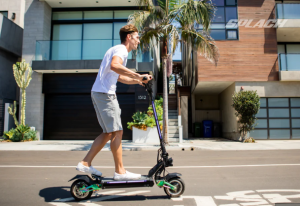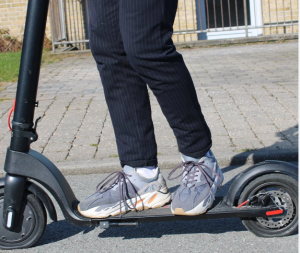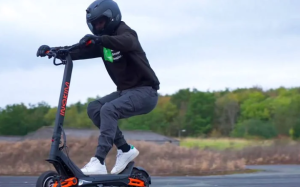The best position on an electric scooter involves a balanced stance, bent knees, straight back, and relaxed arms for optimal control.
Fundamentals of Riding Posture
The fundamentals of riding posture on an electric scooter are crucial for ensuring a safe, comfortable, and efficient ride. Proper posture not only enhances control but also minimizes fatigue and the risk of injuries.
Optimal Stance for Balance and Control
Feet Positioning: Place your feet shoulder-width apart on the scooter deck. This stance offers stability and balance, especially when maneuvering through turns or over uneven surfaces. The front foot should point forward, while the rear foot can be at a slight angle for additional support.
Knee Flexibility: Keep your knees slightly bent. This position acts as a natural shock absorber, making the ride smoother over bumps and reducing stress on your joints.
Center of Gravity: Maintain your center of gravity over the middle of the scooter. Leaning too far forward or backward can cause loss of control, especially at higher speeds or when braking.
Adjusting Your Body for Maneuverability
Upper Body Position: Lean slightly forward from your waist, keeping your back straight. This posture enhances aerodynamics and allows quick, responsive movements.
Arm Position: Keep your arms relaxed but firm on the handlebars. They should be slightly bent at the elbows, which helps in absorbing shocks from the road and provides better control during turns.
Head and Eye Movement: Always look ahead, not down at your feet. This ensures better anticipation of road conditions and keeps you aware of your surroundings.
Hand and Arm Positioning
Proper hand and arm positioning is vital for maintaining control and ensuring safety while riding an electric scooter. This positioning affects your ability to steer, balance, and react to different riding conditions.
Grip and Handlebar Alignment
Handlebar Grip: Hold the handlebars firmly but without excessive tension. A tight grip can lead to fatigue, while a too-loose grip might reduce control. Your thumbs should wrap around the handlebars, with fingers easily reaching the brake levers.
Alignment with Shoulders: Align your arms so they are a natural extension of your shoulders. This alignment reduces strain on your shoulders and arms, allowing for a more comfortable ride, especially during longer trips.
Wrist Position: Keep your wrists straight. Bending them too much can lead to discomfort or strain, and it can also impair your ability to react quickly.
Signaling and Turning Techniques
Signaling: Always signal your intentions to turn or change lanes. Use hand signals by extending your arm in the direction you intend to turn. This not only complies with road safety rules but also alerts other road users to your movements.
Turning Technique: When turning, slightly lean your body into the turn while keeping your scooter upright. This technique improves balance and control. Make smooth and gradual turns, especially at higher speeds, to maintain stability.
Practice and Adaptation: It’s essential to practice these techniques in a safe area before heading into traffic. Over time, adapt your hand and arm positioning to your specific electric scooter model, as handlebar height and design can vary, affecting your grip and control.
Foot Placement and Weight Distribution
The way you place your feet and distribute your weight on an electric scooter is crucial for maintaining stability and control. Proper foot placement and weight distribution are essential for safe and efficient riding, especially when navigating through various terrains and turning.
Ideal Foot Position on the Deck
Front Foot: Place your front foot near the front of the deck, pointing straight ahead or slightly angled. This position provides stability and helps in steering the scooter.
Rear Foot: Your rear foot should be closer to the back of the deck, either parallel to the front foot or at a comfortable angle. This stance allows for quick adjustments in balance and is essential for braking.
Deck Space Utilization: Make sure to utilize the space on the deck effectively. Crowding your feet too close together can lead to instability, while spreading them too far apart may reduce your ability to control the scooter.
Shifting Weight for Stability and Turns
Leaning for Turns: When turning, shift your weight slightly towards the direction of the turn. This movement helps in maintaining balance and ensures a smooth turn.
Forward and Backward Weight Shift: When accelerating, lean slightly forward to counteract the backward pull. Similarly, when braking or going downhill, shift your weight backward to prevent tipping forward.
Adjusting to Speed: At higher speeds, it’s crucial to maintain a more centered weight distribution to ensure stability. Sudden shifts in weight at high speeds can be dangerous.
Safety Considerations in Riding Posture
Ensuring safety while riding an electric scooter involves more than just mastering the controls; it also requires adopting a riding posture that maximizes stability and responsiveness. This includes understanding the impact of protective gear on your posture and being aware of common mistakes to avoid.
Protective Gear and Its Impact on Posture
Helmet: A properly fitted helmet is crucial. It should be snug but not overly tight, allowing for full head movement without obstruction. A helmet that’s too heavy or poorly fitted can affect neck posture and overall balance.
Padding and Clothing: Elbow and knee pads should fit comfortably, allowing free movement. Bulky or restrictive gear can impede your ability to maneuver the scooter effectively.
Visibility and Posture: High-visibility clothing helps others see you, especially in low light conditions. Ensure that these clothing items don’t restrict your movement or alter your natural riding posture.
Common Mistakes and How to Avoid Them
Overleaning: Avoid leaning too far forward or backward, especially at high speeds or when braking. This can lead to loss of control or tipping.
Locked Joints: Keep your knees and elbows slightly bent. Riding with locked joints can lead to discomfort and doesn’t allow for effective shock absorption.
Distractions and Posture: Avoid distractions such as using a phone or headphones while riding. These distractions not only impair your ability to react but can also cause you to adopt an unsafe posture.
Fatigue and Posture: Pay attention to signs of fatigue. Tired riders tend to slouch or adopt poor postures, increasing the risk of accidents.
Adapting to Different Electric Scooter Models
Riding an electric scooter efficiently requires adapting your posture to different models, each with its unique design and performance characteristics. This adaptation is crucial for ensuring safety, comfort, and control, regardless of the scooter’s specifications.
Variations in Scooter Design and Implications for Posture
Deck Size and Height: Scooters with larger decks provide more foot space, affecting your stance. A lower deck height can offer better stability, but it may require a more bent knee posture for shock absorption.
Handlebar Height and Width: Scooters with adjustable handlebar heights cater to riders of different sizes. A handlebar that’s too high or too low can cause back strain or affect steering control. The width of the handlebars also plays a role; wider bars offer more stability but require a broader arm stance.
Wheel Size and Suspension: Larger wheels can handle uneven terrain better, but they might alter the scooter’s center of gravity. Scooters with suspension systems can absorb shocks better, allowing a more upright posture.
Adjusting Posture for Speed and Terrain
High-Speed Riding: When riding at higher speeds, adopt a more aerodynamic posture by leaning slightly forward. This reduces air resistance and improves control. Always ensure that your posture allows quick access to the brakes.
Riding on Rough Terrain: For off-road or uneven surfaces, increase your knee and elbow flexibility. This posture helps absorb shocks and maintain balance.
Climbing and Descending Hills: While climbing, lean forward to distribute your weight evenly and prevent the scooter from tipping backward. During descents, shift your weight backward to counterbalance the downhill force.


